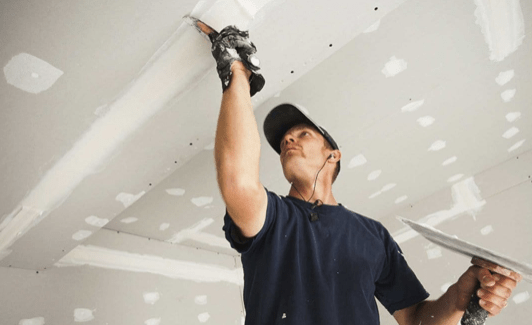20 Things You Need to Know About Repairing Drywall
Irrespective of whether it’s a small hole or a gaping one, a hole in the drywall creates an unsightly blemish that must be fixed. Here are 20 essential things to guide you through repairing a drywall, from understanding the basics to mastering the process.
Pre-Repair Considerations
Before heading to the hardware store, keep these points in mind to plan your purchases effectively:
- Repaint or Touch-Up? Decide if you want to repaint the entire wall or just touch up the patched areas. For very small holes, touch-up paint applied with a soft cloth can suffice.
- Priming for Large Repairs: If you’re patching a larger area, prime over the patched spots before repainting, especially if using semi-gloss or shiny paint. Higher gloss paints highlight differences in surface texture between the patched area and the surrounding paint.
Word of Caution
Before making the repair, it is vitally important to know precisely where your home’s utility placement is. Typically, wall studs are used to attach electric wires. Before you begin drilling, cutting, or nailing, locate the wall studs so you know exactly where the wiring runs.
Tools and Materials You Will Need
- Scrap Drywall
- 3/4″ x 2″ Furring Strips
- Fiberglass Mesh Tape
- Drywall Joint Compound
- Pencil
- Construction Adhesive
- Painter’s Putty
- Putty Knife
- Trowel
- Drywall Saw
- Drywall Screws
- Blade Knife
- Cordless Drill
1. Assess the Damage
Before you start, examine the extent of the damage. Small nail pops and minor dents require different approaches than large holes or water damage.
2. Understand the Materials
Knowing what materials you’ll need is crucial. These include scrap drywall, furring strips, fiberglass mesh tape, drywall joint compound, and various tools like a blade knife, putty knife, and cordless drill.
3. Choose the Right Tools
Having the correct tools will make the job easier and ensure a professional finish. Essential tools include a drywall saw, trowel, and painter’s putty.
4. Safety First
Always locate utility lines before you begin drilling, cutting, or nailing. Wall studs typically secure electric wires, so knowing their placement is crucial.
5. Small Repairs Can Be Simple
For small holes, such as nail pops, painter’s putty and touch-up paint might be all you need.
6. Larger Repairs Require More Effort
Larger holes will need a patch of drywall, screws, and possibly wooden supports to hold the patch in place.
7. Clean the Area First
Always clean the area around the damage before starting the repair. This ensures better adhesion for the patch and compound.
8. Use Quality Materials
Invest in good quality joint compound and drywall patches. This can make a significant difference in the durability and appearance of the repair.
9. The Role of Primer
If you’re patching a larger area, using a primer before repainting can help the new paint blend seamlessly with the old.
10. Steps to Patch Small Holes
- Clean the hole using a blade knife, making the exterior larger than the interior.
- Fill the hole with painter’s putty and level it with the wall surface.
- Allow the putty to dry, then sand the area until smooth.
- Spackle over the putty if necessary and sand again.
11. Steps to Patch Medium Holes
- Use a drywall metal patch.
- Sand the surface around the hole.
- Apply the patch, pressing it firmly in place.
- Spread drywall compound over the patch, feathering the edges.
- Allow it to dry, then sand smooth.
12. Steps to Patch Large Holes
- Cut a drywall patch slightly larger than the hole.
- Trace the patch outline around the hole and cut out the damaged area.
- Attach wooden boards behind the hole to support the patch.
- Screw the patch to the boards.
- Spread drywall compound over the patch and cover with mesh tape.
- Sand the area smooth and repeat as necessary.
13. Sanding is Key
Sanding between layers of compound is crucial for a smooth finish. Use fine-grit sandpaper for best results.
14. Feathering Technique
Feathering the edges of the compound helps blend the patch into the existing wall seamlessly.
15. Multiple Layers
Apply multiple thin layers of compound rather than one thick layer. This prevents cracking and ensures a smooth finish.
16. Drying Time
Allow sufficient drying time between layers of compound and before sanding or painting.
17. Dust Management
Drywall repair generates a lot of dust. Use drop cloths and cover furniture to protect your home.
18. Touch-Up Paint
Match your touch-up paint carefully to the existing wall color to avoid noticeable patches.
19. Professional Help
For extensive damage or if you’re unsure about the process, hiring a professional can save time and ensure a high-quality repair.
20. Regular Maintenance
Regularly check your walls for signs of damage or wear and address issues promptly to prevent them from worsening.
Conclusion
Repairing drywall doesn’t have to be daunting. With the right knowledge, tools, and materials, you can achieve professional-looking results. For more significant repairs or to ensure the job is done right, consider hiring a professional like a door frame repairman or a drywall specialist.
For expert drywall repair services, contact Sacramento Handyman at 916-472-0507 or request a free quote here.

You repair the medium hole and how much u charge in Sacramento ca natomas